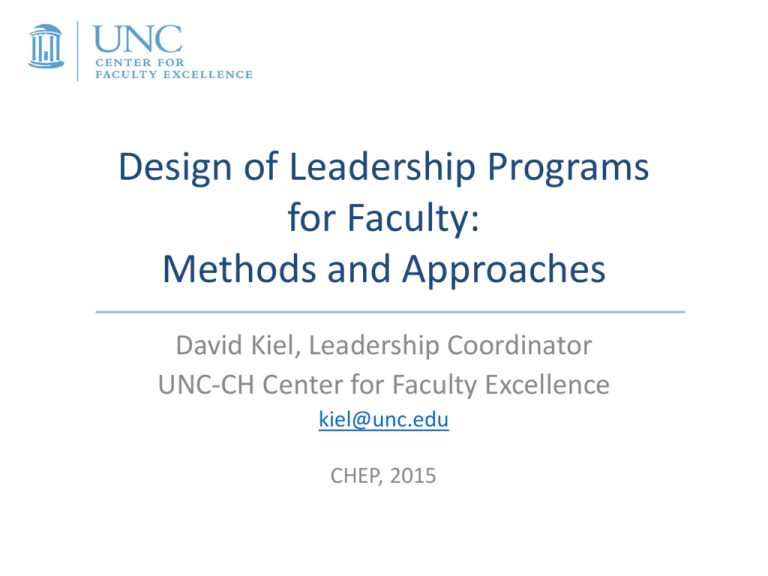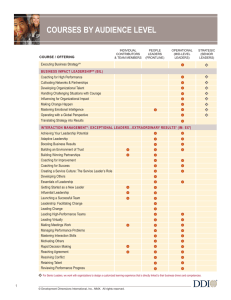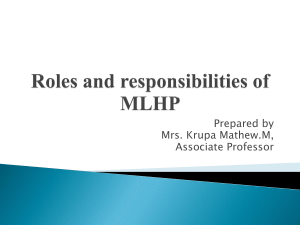Document
advertisement

Design of Leadership Programs for Faculty: Methods and Approaches David Kiel, Leadership Coordinator UNC-CH Center for Faculty Excellence kiel@unc.edu CHEP, 2015 Higher Education Is Facing Challenges Short List of Challenges Facing Higher Education Declines In Public Funding Increases In Costs Rapidly Changing Technology Declining Infrastructure The Need To Increase Diversity More Contentious Stakeholders Partisan Polarization Globalization Troubling Campus Safety Issues Decline In Faculty Morale Declining Middle Class Incomes Increasing Student Debt Lower Graduation Rates For Minorities A Knowledge Explosion Creation Of New Media In The Arts New Disciplines In The Sciences Restiveness Of Graduate Students Excessive Length Of Time To Some Graduate Degrees Increasing Pressures To Show Vocational Relevance Higher Education in the US If Faculty Do Not Lead, Who Will? • • • • • • IHE’s have multiple stakeholders Corporate vs. academic values Disciplinary nature of academic units Each unit and discipline will need to respond Only faculty can lead a response Preserving academic values through change Mid-Level Leaders Are Key • • • • • Chairs, center and institute directors, associate deans New incumbents Experienced leaders Emerging leaders The leadership “pipeline” Issues Facing Mid-Level Leaders • • • • • • • • • Unit Strategy Funding Recruitment and retention Marketing Communications Personnel management Change management Conflict Quality in curriculum, teaching, service, and research Issues Facing Faculty Leaders • • • • • • • • • • • Facilities Operations Technology Innovation Diversity Safety Global Outreach Interdisciplinarity Public Service Athletics Student Life Support Is Lacking, and Providing the Support Is Not a Simple Matter • • • • • Mid-level leaders are not prepared Mid-level leaders lack support to learn to lead Existing HR programs are not targeted toward faculty We need a whole new set of programs Leadership is a complex and diverse set of competencies What Leaders Need to Lead • • • • • • • Opportunities for learning at multiple career points Opportunities for shared problem-solving Connection to helping systems, people Connection to other leaders: vertical, horizontal Access to best practices Time and incentives to lead Strong administrative staff What Leaders Need to Know • Broad perspectives and knowledge about higher education • Role and institution-specific knowledge • General leadership and management skill and knowledge • Core interpersonal, analytical, and self-management skills Meeting This Challenge Will Require Resources Meeting This Challenge Will Require Time and Energy How to Solve It: An Incremental Approach 1. “Collect the dots”—program development – – – – Target one specific need at a time Tailor learning objectives and formats Develop resources and sponsorship Pilot, revise, and sustain 2. “Connect the dots”—curriculum building 3. Fill in the gaps—continuous improvement 4. Long-term resource development UNC-CH Programs: A Mix of Audiences, Sponsors, Styles, Campus-wide • • • • • • ALP – Seminar Style: emerging leaders CLP – Support Group Style: new incumbents Core Skills – Short Course Style: open enrollment FADP – Orientation Style: new incumbents U-Lead – Institute Style: rising leaders FLC – Coaching style: experienced leaders School of Medicine • • • Leadership Programs for Chairs: coaching service ACCLAIM Program: minority retention UNC System • • Entrepreneurship Boot Camp – Immersion Style: experienced leaders Bridges (serves women faculty and staff) – Institute Style When to Provide Opportunities • • • • • • For potential leaders For emerging leaders For new incumbents For established leaders For rising leaders For established leaders in transition Other Support Options • • • • • • • • • • Consultation services Multi-campus leadership programs External vendors Professional associations Coaching Peer coaching Online information and resources Blended learning and virtual options Learning communities Continuing support groups Lessons Learned • • • • • • • • Address faculty values and needs Link to clear priorities and goals Focus on one audience at a time Address needs Be opportunistic Adapt style to purpose Fit program to resources Establish a personal contact Lessons Learned • • • • • • • Address the career context Build a clientele Work with senior leaders Find the right sponsors Support multiple programs and offerings Flexibility about funding Work to secure continuous funding Ultimately, Leadership Is About: The institutions we love and the people we serve, so let’s do it right!











